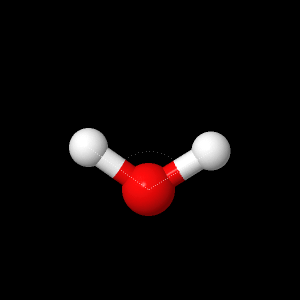Water (H2O)
Geometry Optimization
Optimized Geometries of the H2O model were obtained using three different levels of theory, specifically 6-21G, 6-31G, and Double Zeta Valence (DZV). The H2O model displayed on the right were made using DZV, the highest ab initio level of theory.
The button bellow displays the optimized geometry, H-O Bond Length, and H-O-H Bond Angle obtained using the DZV level of theory.
|
|
Table 3 compares the H-O bond lengths and H-O-H bond angles obtained for the three levels of theory and the literature value.
| Level
of Theory |
H-O
Bond Length (┼) |
H-O-H
Bond Angle |
| 6-21G 6-31G DZV Literature |
0.96 0.95
0.950.95 |
103.5║ 111.5║ 112.6║ 104.5║ |
The button bellow displays the HOMO of water.
|
|
The button bellow displays the LUMO of water.
|
|
The electrostatic potential of the molecule visually provides information about the charge distribution, polarity, and shape of the molecule . Red areas indicate high electron density. Blue areas indicate low electron density. The sizes of these regions vary depending on the differences in electronegativity of the molecules in the bond. The button bellow displays the electrostatic potential map for H2O.
|
|
Moreover, the electronegativity of the constituents of the molecule indicate where partial charges are likely to be found. More electronegative atoms yield a more negative value and least electronegative atoms yield a more positive value. Note here that the greater the difference between partial charges within a molecule, the more polar the molecule. The button below shows the partial charges in H2O.
|
|
Table 4 lists the calculated dipole moment for H2O. Values were obtained using different levels of theory including diffused functions.
Table 4. Comparison of Dipole Moment for Water obtained from Diffused and non-Diffused Functions of 6-21G, 6-31G, and DZV Levels of Theory. #d, #f, and #small atom represents the different D heavy atom polarization functions, F heavy atom polarization functions, and small atom polarization functions respectively. The unit D is equal to Debye.
| Level
of Theory |
#d |
#f |
#small
atom |
Dipole
Moment (D) |
| 6-21G |
0 1 2 2 2 |
0 0 0 0 0 |
0 1 1 2 3 |
2.367 2.215 2.215 2.025 1.817 |
| 6-31G |
0 1 1 1 2 3 |
0 1 1 1 1 1 |
0 1 2 3 3 3 |
2.501 2.167 2.072 1.951 1.904 1.926 |
| DZV |
0 1 2 3 3 3 |
0 0 0 0 0 0 |
0 1 1 1 2 3 |
2.534 1.988 2.012 1.942 1.944 1.947 |
| Literature |
- |
- |
- |
1.850 |
Table 4 depicts how diffused functions affect the resulting dipole moment for the three different levels of theory. The default function, where #d, #f, and #small are equal to zero, calculated relatively deviated dipole moments of water with respect to the literature value. Adding diffused functions improved the results, although it varies depending on which level of theory where the diffused functions were applied. In other words, the diffused functions interact differently with each basis sets depending on which level of theory it was applied to. Specifically, for 6-21G basis set, changing the D atom polarized function does not affect the resulting dipole moment, although changing the small atom polarized function gave better results as the functions were changed from 1 to 3. For the 6-31G and DZV basis sets, larger basis sets relative to 6-21G, adding #d, #f, and #small atom diffused functions improved the resulting dipole moment. Yet, the smallest basis set with diffused functions, specifically 6-21G with 2-0-3 diffused functions gave the closest value to the literature. This directly implies that larger basis set does not necessarily mean better results in calculating dipole moments. Additionally, by comparing the H-O-H bond angles, as shown in Table 3, the angles calculated may have affected the resulting dipole moment in Table 4. Notice that the bond angle obtained for 6-21G geometry optimization was closest to the literature value, which then resulted in better dipole moment calculation after the diffused functions were applied.
Vibrational Frequencies
This link provides the IR spectrum of water from the NIST database which were compared to the the vibrational frequencies obtained using DZV.
Bellow are models of the main vibrational modes of motion of water which corresponds to a specific frequency.
The button Vibrational Motion 1 displays the asymmetrical stretching mode of motion of water which corresponds to a vibrational frequency of 4211 1/cm
|
|
The button Vibrational Motion 2 displays the symmetrical stretching mode of motion of water which corresponds to a vibrational frequency of 4034 1/cm
|
|
The button Vibrational Motion 3 display the scissoring mode of motion of water which corresponds to a a vibrational frequency of 1714 1/cm
|
|
